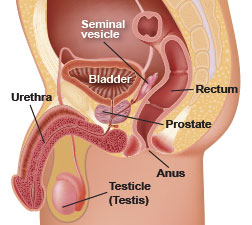
Tailoring Technology to Treatment
 Location of the Prostate Gland
Location of the Prostate Gland
What is the prostate gland?
The prostate is a small gland about the size of a walnut, which lies just below the bladder in men. The tube draining the bladder, called the urethra, passes through the centre of the gland to the penis.
A valve mechanism, or sphincter, maintains continence and stops urine leaking out of the bladder. The sphincter is located below the prostate gland.
The prostate gland is part of the male reproductive system. It develops at puberty and then continues to enlarge after the age of 40. Women do not have a prostate gland and therefore cannot get prostate cancer.
The prostate gland acts rather like a junction box. It allows the tubes that carry sperm from each testicle, and the tubes that drain from the seminal vesicles to meet and then empty their contents in to the urethra. (The seminal vesicles consist of two pouches that provide nutrients for the sperm and lie immediately behind the prostate).
At the point of orgasm sperm, seminal vesicle fluid and prostatic secretions enter the urethra and mix together forming semen. This is then ejaculated out through the penis by rhythmic muscular contractions.